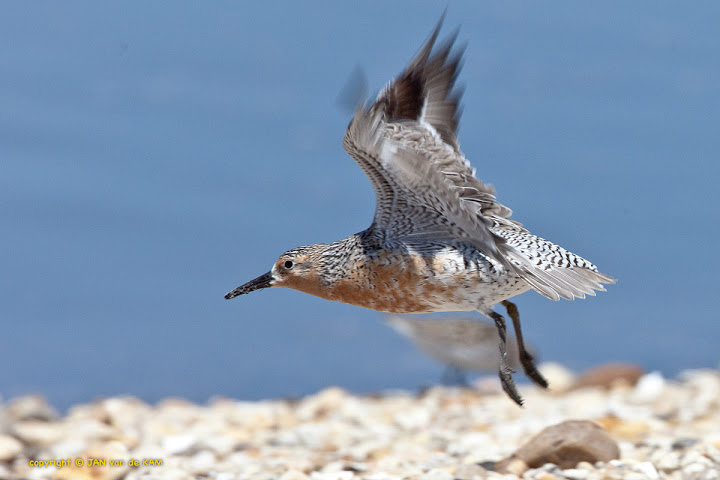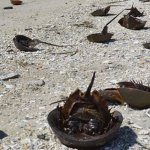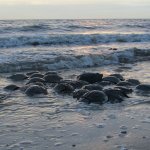By Adriana Manchen, Delaware Bay Program Assistant and huge Red Knot fan
B95! B95! B95! That is what I dream of hearing this spring on the Delaware Bay. No, I am not going to be playing BINGO on the bay. In fact, those of you that do play BINGO know that there is no such call in the game.
I had no idea who B95 was until two years ago. In January of 2013, I was getting ready to make my great own “migration” to New Jersey, with a big move with my family. Around the same time, a little shorebird with an orange flag on his left leg that reads B95, was getting ready to do the same.

Photo: Jan van de Kam.
B95 is a rufa Red Knot. Amazing athletes, they manage to fly from the southernmost tip of South America to the Arctic tundra and back every year. That is about 18,000 miles of flying for a bird that weighs a mere four to six ounces. These birds encounter a multitude of natural and man-made challenges along their migration route. This is why the story of B95 is so incredible.
B95 was first tagged in 1995 and was at least two years old at the time. That would make him at least 22 years old now. This is astounding considering how may red knots perish within their first year of life. If they make it to adulthood, scientists believe most don’t make it past age seven.
Our amazing little friend has traveled over 400,000 miles in his lifetime. When he was an estimated 16 years old, he reached a special milestone. By that point he had traveled, in distance, to the moon and half way back. From that moment forward, he became known to many as Moonbird.

Photo: Jan van de Kam.
Moonbird has quickly become the face of shorebird conservation, with more and more new fans every year. I became a fan shortly after my move to NJ. One day in April, after a day of unpacking and organizing, I ran across an article online discussing the impending arrival of the Red Knots in May. I did some research on knots and immediately stumbled onto stories, websites, songs, videos, and any other media you can think of, all honoring the little Moonbird. I was HOOKED!
I did attempt to see him and the other knots that May, but I missed them by a few days. Even though I was disappointed, Moonbird and the knots stayed on my mind. The following May, in 2014, I went out again to see if I could get a glimpse of these remarkable animals that stop at the bay for only two weeks a year to feast on horseshoe crab eggs. Alas, I missed them again.
These trips out to the Bay were not in vain. I was able to learn more about the interconnectedness of the species that share the Delaware Bay and how essential the bay is to the survival of Red Knots and all migrating shorebirds and other wildlife. I also learned more about the challenges that they are faced with throughout their entire migration- overharvesting of horseshoe crabs, sea level rise, extreme storms, human disturbance, and coastal development.
The challenges these birds face left me feeling frustrated, but also inspired to find more ways to get involved. As residents of the Delaware Bay region, we have the power to turn the tide and help these animals that rely on the Bay recover.
There are many ways for you to join us on the Bay this spring and hope your experience will be as life changing as mine. Moonbird pulled me back into working for wildlife and for that I am forever grateful. I can’t wait to share that inspiration with others. And in case you are wondering. I’ve since learned that for the best chance of seeing knots on the Bay- get out there during peak season. May 11th-May 28th.
To learn more about Moonbird and other rufa Red Knots check out Phillip Hoose’s book, Moonbird: A Year on the Wind with the Great Survivor B95.






